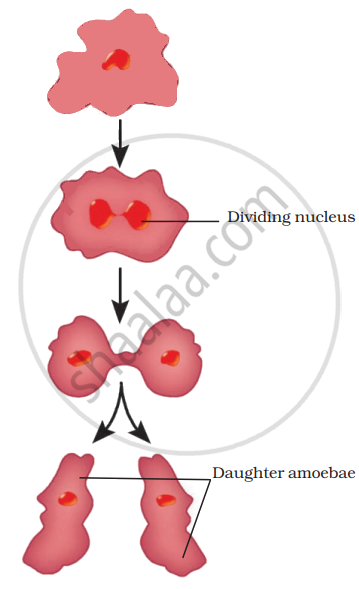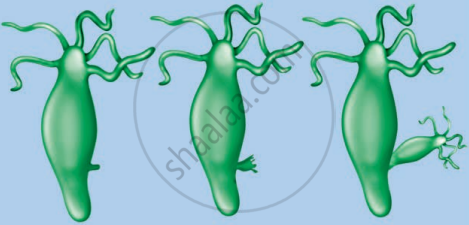Advertisements
Advertisements
Questions
Describe the different methods of asexual reproduction in animals.
Describe two methods of asexual reproduction in animals.
Solution 1
The different methods of asexual reproductive in animals are:
1. Binary fission: Common in unicellular organisms like Amoeba and Paramecium. Parent cell divides into two halves which grow into new organisms.

2. Multiple fission: This reproduction takes place in unfavourbale conditions. Example in Plasmodium, it develops a thick coat called cyst. Nucleus divides into many nuclei which form spores or daughter cells. Under favourable conditions, these grow into new individuals.

3. Budding: An outgrowth called bud arises on the parent body and detaches to form a new organism. Example: Hydra.

4. Fragmentation: Sponges and flatworms show this type of reproduction. Parent body divides into fragments and each fragment grows into new individuals.

5. Regeneration: Animals can repair themselves or grow lost parts again. Example: Broken tail of lizard grows back again. Starfish can grow into a new animal from its broken arm. It is more prominent in simple animals. Complex organisms like mammals cannot regenerate whole parts like arms, nails, hair, skin cells, etc., are regenerated.

Solution 2
Two methods of asexual reproduction in animals are:
- Binary fission: It is a type of asexual reproduction in which a single cell divides into two halves. Organisms that reproduce through binary fission are bacteria and Amoeba. In Amoeba, the division of cells can take place in any plane. It involves the division of its nucleus into two nuclei, which is followed by the division of its body into two halves. Each half of the body receives a nucleus.

Binary fission in Amoeba - Budding: Budding involves the formation of a new individual from the bulges, known as buds formed on the parent body. This method of reproduction is common in Hydra.In Hydra, thecells divide rapidly at a specific site and develop as an outgrowth, called the bud. These buds, while being attached to the parent plant, develop into smaller individuals. When these individuals become mature enough, they detach from the parent’s body and become independent individuals.

Budding in yeast
Notes
Students should refer to the answer according to their question.
RELATED QUESTIONS
Define sexual reproduction.
The figure given alongside shows the human male reproductive organs. Which structures make sperms and seminal fluid?
(a) V makes sperms and X makes seminal fluid
(b) W makes sperms and Y makes seminal fluid
(c) X makes sperms and W makes seminal fluid
(d) Y makes sperms and V makes seminal fluid
Put a tick mark (✓) against the correct alternative in the following statement:
Amoeba is most commonly reproduced by:
Define the term Adolescence.
Define the term Puberty.
Answer in one sentence.
Outline the path of sperm upto the urethra.
Give an account of external genitalia in human females.
Animals which give birth to young ones directly are named as ______.
Give reason for the following:
Some organisms like honey bees are called parthenogenetic animals
Explain the formation of the embryo.
